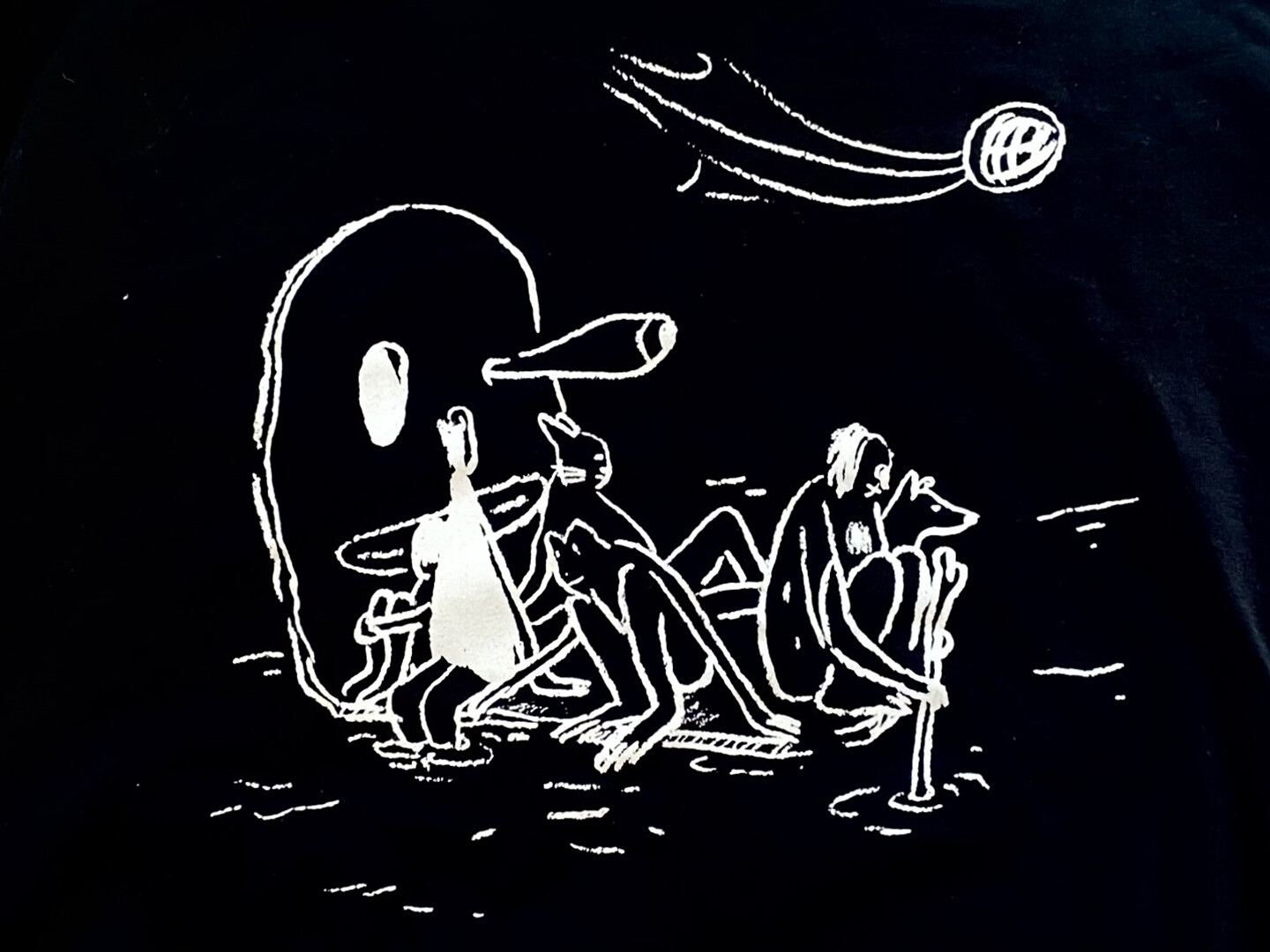Prefiguration, Emergence, Divergence
With the return of certain Cold War dynamics, the social imaginary is undergoing a renewed reduction. In the wake of the Russian invasion of Ukraine, Sandro Mezzadra looked back to the distant times of 2003, when the New York Times called the peace movement coming out of Seattle, Porto Alegre, and Genoa the “second world power.”1 If “another world is possible” is the slogan that best encapsulates the last two to three decades of nondogmatic (autonomist, alter-globalist, Indigenous, abolitionist) emancipatory politics, today the risk is all too real that the possible alternatives will be reduced to currently available models.
The historian Kenneth Pomeranz famously characterized the emergence of industrial capitalism in eighteenth-century Europe, and not under broadly similar conditions in East Asia, as “the great divergence.”2 Today, China’s status as an economic and political threat to the West obscures the reconvergence that has taken place as various varieties of capitalist statecraft face off against each other. The only “world powers” today appear to be those that curtail emancipatory forces in different ways and to different degrees (and those degrees do, of course, matter deeply). Or is this appearance of stifled possibilities precisely part of the problem, a symptom of a receding revolutionary horizon?
Questions of prefiguration and emergence loom large in the current conjuncture, in the present planetary pickle. While the terms “prefigurative practice” and “prefigurative politics” only gained some traction in the 1970s and ’80s, and particularly in more recent years in post-Occupy anarchist and autonomist theory, the concept of practices that materially anticipate postcapitalist and antiauthoritarian social forms has a much longer history on the left.3 No doubt the realization of this ideal was always a compromised and contradictory affair, for anarchists and for Marxists alike, due to internal and external factors. In a remarkable 1928 book, the Austrian Marxist Otto Neurath mused on the possibilities and limitations of socialist Lebensgestaltung (the organization of life) or attempts to create new Lebensformen (forms of life) under capitalism. While clinging to a highly problematic theory of the unavoidable transformation of capitalist planning into a moneyless socialist planned economy, Neurath was nonetheless a keen and nuanced observer of the ways in which the practice of socialist activism was shaped by existing conditions; building socialist organizations under capitalist conditions was obviously a contradictory and vexing task. Even so, Neurath argued that proletarian organizations—especially youth organizations and forms of self-organized education—offered an anticipation of a kommene Lebenssstimmung, a coming “mood of life.”4
Among cultural disciplines, it was architecture that Neurath deemed of central importance, with the architect having the task of anticipating both technological and social developments in the near future, including “Änderungen der Lebensformen” (changes in the forms of life).5 Such remarks are suggestive in the context of contemporary aesthetic practices that seek to common or decolonize the means of artistic and intellectual production, which can easily be chided for amounting to little more than a woke reshuffling of the deck chairs on the Titanic. However, Neurath’s use of the storied term Lebensformen—recently revived by authors like Giorgio Agamben and Rahel Jaeggi—drives home the point that any crudely economistic relegation of culture to a merely superstructural epiphenomenon must be rejected.6 Yes, the capitalist value-form informs and deforms many Lebensformen and social relations—but its reign is not homogeneous, its sovereignty not absolute. As Raymond Williams rightly insisted already in 1973: “No mode of production, and therefore no dominant society or order of society, and therefore no dominant culture, in reality exhausts the full range of human practice, human energy, human intention.”7
In his writings on dominant, residual, and emergent forms of culture, Williams maintained that “new meanings and values, new practices, new relationships and kinds of relationship are continually being created” within and against the dominant, and beyond residual or archaic elements.8 When Williams began to theorize the concept of emergent social and cultural forms in the 1970s, the Western New Left tended to adhere to a strictly class-based analysis of historical development, though there was much debate about the relative importance of revolutionary “class consciousness” in relation to economic parameters—with Perry Anderson, for instance, emphasizing the importance of “those collective projects which have sought to render their initiators authors of their collective mode of existence as a whole, in a conscious programme aimed at creating or remodeling whole social structures.”9 While the historical dialectic of feudality/aristocracy and bourgeoisie/proletariat informs Williams’s account of residual, dominant, and emergent forms, on a fundamental level he insists that in any given order “there is always other social being and consciousness which is neglected and excluded: alternative perceptions of others, in immediate relationships; new perceptions and practices of the material world.”10 Hegemony is never total; “those practices, experiences, meanings, values which are not part of the effective dominant culture” can go from being alternative to being properly oppositional.11
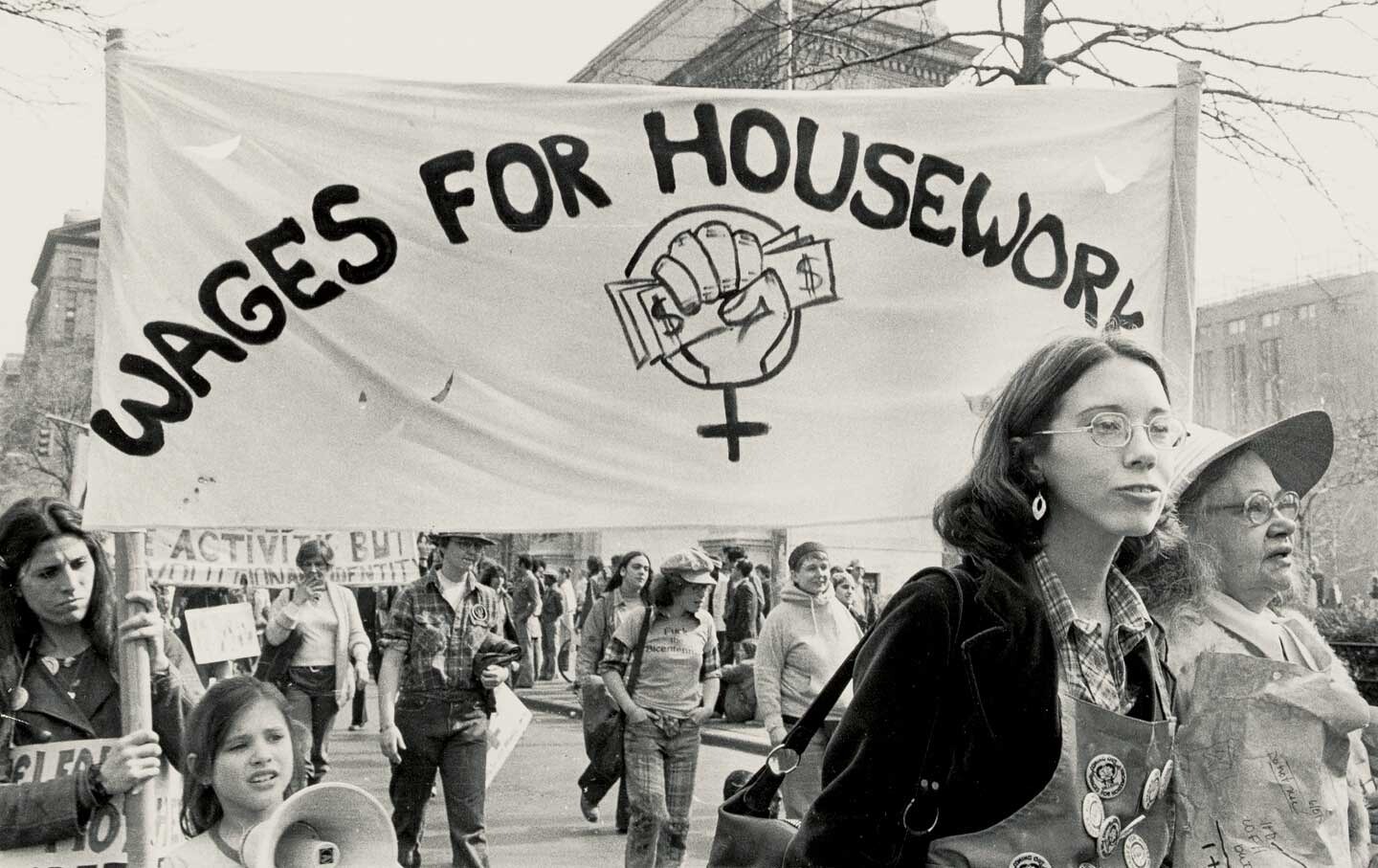

A Wages for Housework march, 1977. Source: Schlesinger Library, Radcliffe Institute / Bettye Lane.
For all his undogmatic subtlety, Williams never paid significant attention to the problematizations of Marxist accounts of class that were emerging from Black, anti-colonial, feminist, and queer movements. As the seventies progressed, an increasing divergence became apparent between a (male- and white-dominated) class-focused Marxist political theory and practice and emergent autonomous social movements. It should be noted that in the context of the seventies, the notion of autonomous social movements often referred less to Italian autonomous Marxism than to more expansive feminist, gay, or Black groups that had become autonomous from any Marxist vanguard—even in its post-Leninist, operaist guise.12 A key example of a feminist movement with some roots in autonomous Marxism, while challenging its parameters in a process of immanent critique, is the Wages for Housework campaign, whose key theorists and organizers included Mariarosa Dalla Costa, Selma James, and Silvia Federici.
Indicative of the tensions between various “autonomous movements,” Wages for Housework—like 1970s feminism in general—is often accused of disregarding the struggles of women of color, or the labor performed by Black women outside of the heteronormative white household. This accusation hardly holds for someone like Selma James; through her background in C. L. R. James’s post-Trotskyist Forest-Johnson tendency and in feminist community work, James developed a seminal analysis of the dialectic of “class” and “caste”—the latter being her term for nonclass identity in terms of gender and race, which is “the very substance of class,” as she put it.13 The objective of her early intersectionalism was not to play these categories off against each other, but to do justice to the “complex interweaving of forces” in social composition—noting, for instance, that “Black women will know what organization (with Black men, with white women, with both, with neither) to make that struggle. No one else can know.”14 Thus, we are dealing with an analysis that complements and complicates Williams’s account of emergence. Multiple identities may diverge and remerge over time. Black Marxists become Black nationalists, female socialists become feminists, queer theorists and anti-racist activists create coalitions for social justice that go beyond and challenge reductive notions of identity politics—even while lines keep being drawn among those who might be allies or, beyond that, comrades.15
Just what, then, is it that emerges in activist circles, in marginal milieus, in artistic and intellectual networks? Today’s forms of emergence seem less like prefigurations of a foreordained future and more like forms of divergence that may or may not become concatenated to the point where they would amount to a great divergence. As “collective projects” and “collective agency” take on new and complex forms, how can processes of collective self-identification be grasped—not just historically, but also for the social media–driven present? How can such processes be intervened in and shaped? What is the role of disidentification between various “peoples” who cast each other in the role of other, alien, enemy? Are divergences always motivated through negation, by opposition?
Counter-Imitation and Schismogenesis
During the 1970s and into the eighties, a Deleuzo-Guattarian/autonomist shift to molecular micropolitics became pronounced in much theory and activism. Critical of the more orthodox brands of Marxism, Deleuze and Guattari sought out alternative ancestors such as Gabriel Tarde—turning one of the founders of French sociology into a radical thinker, precisely insofar as Tarde was non-dialectical, non-Hegelian, and non-Marxist.16 Opposing a sociology that fetishizes binary and overcoded “collective representations,” such as class, Deleuze and Guattari appreciated Tarde’s micropolitical, molecular attention to “the little imitations, oppositions, and inventions constituting an entire realm of subrepresentative matter.”17 Tarde thus proved surprisingly relevant in the context of the molecular revolution that was inaugurated in May ’68. In A Thousand Plateaus—the second volume of their Capitalism and Schizophrenia—Deleuze and Guattari quote him as arguing that in order to understand revolutionary transformations, “what one needs to know is which peasants, in which areas in the South of France, stopped greeting the local landowners.”18 While they obviously do not use Williams’s terminology, Deleuze and Guattari can be said to side with forms of preemergence that may never fully settle into familiar identity categories such as class.
A central concept of Tarde’s social philosophy is imitation, which he defined as “action at a distance of one mind upon another.”19 Distinguishing between imitation and counter-imitation, Tarde notes that some social actors are associated with each other in the negative, by virtue of being adversaries. Deleuze and Guattari note Tarde’s focus on “the little imitations, oppositions, and inventions constituting an entire realm of subrepresentative matter,” but they abstain from discussing his analysis of imitation in the realm of representation par excellence: the media and the opposing publics they constitute.20 In Tarde’s words:
No opinion is discussed by the press about which, I repeat, the public is not daily divided into two camps, those who agree with the opinion and those who disagree. But the latter as well as the former admit that it is impossible to be concerned for the time being with anything other than the question which is this forced upon them.21
Around 1900, in the wake of the Dreyfus Affair, in which the French media had fueled anti-Semitic conspiracy theories, Tarde distinguished between the crowd (which had been theorized by Le Bon) and the public: the former is an embodied assembly, whereas the latter is a virtual entity created by print media, and, as such, is a distinctly modern phenomenon. Tarde’s publics are not quite the same as Jürgen Habermas’s idealized “reasoning public”: they are produced and manipulated by professional journalistic agitators and can be as murderous as crowds. Tarde’s print publics already generate filter bubbles. Whereas LeBon had focused on the dangers of the crowd, for Tarde the lesson of the Dreyfus Affair was that publics were less diverse than crowds, and more open to manipulation. In an analysis that takes on new relevance in the age of riots organized on social media, Tarde argued that crowds can become criminal, murderous mobs—but publics too can become criminal if properly molded by opinion makers, and behind every murderous modern mob there’s an even more criminal public.22
It is no surprise that Tarde has become a reference for recent affect-theoretical accounts of the “spreadability” of hate on social media, while Facebook whistleblower Frances Haugen struck a neo-Tardean note when noting that the platform has been designed to foster extremism and hate, testifying to a UK parliamentary committee that “anger and hate is the easiest way to grow on Facebook.”23 Such calculated (counter-)publics perform what one might call an aggressive disengagement with the other side, refusing to enter into even the most critical dialogue and opting instead for endless trolling, physical violence against racialized or sexualized Others, and attacks on institutions and organizations.24 From a Deleuzian perspective, all of this is depressingly molar: the culture wars revolve precisely around overcoded representations of the most noxious kind, imposing segmentations on the molecular assemblages that traverse the social realm. Even the meekest progressive attempts at alleviating necropolitical violence find themselves integrated in a narrative about Woke Antifa Socialists attacking Freedom or the American Way or Christian Values (take your pick).
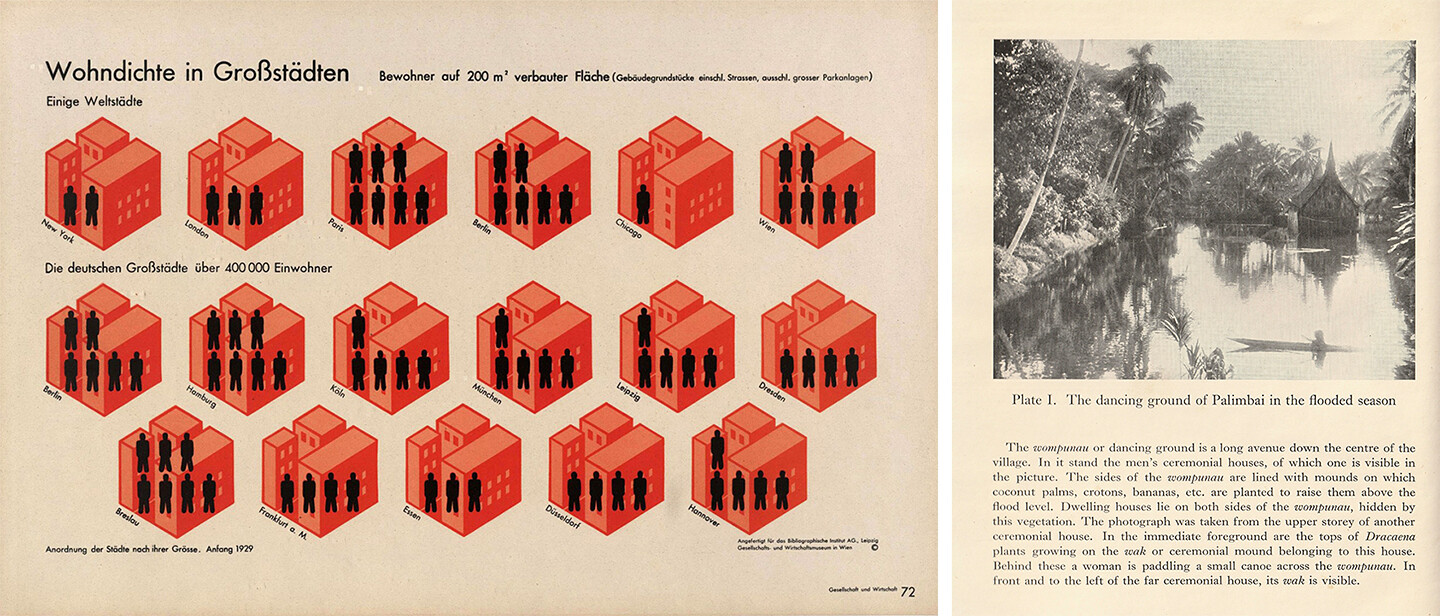

Left: Otto Neurath, diagram showing residential density in major international and German cities,
from Gesellschaft und Wirtschaft, 1930. Right: Page from Gregory Bateson, Naven: A Survey of the
Problems suggested by a Composite Picture of the Culture of a New Guinea Tribe drawn from Three
Points of View, 1936.
This is precisely where Tarde’s sociology of mimesis displays its limitations. From a Deleuzian perspective, the main problem lies in what one could term Tarde’s sociological realism: he attempts to identify and map social forms that are so many processes of capture, so many molar structures imposed on molecular becoming. This is why Deleuze and Guattari need to cherry-pick, and a full encounter with Tarde is avoided. The same applies to Gregory Bateson, whose impact is manifested in the very title A Thousand Plateaus—yet here too Deleuze and Guattari’s appropriation is marked by occlusions and refusals. They note that Bateson uses the term plateau “to designate something very special: a continuous, self-vibrating region of intensities whose development avoids any orientation toward a culmination point or external end.”25 In Balinese culture, according to Bateson, sexually tinted games between mothers and their children substitute a “continuing plateau of intensity” for sexual climax, and Deleuze and Guattari use this to chide Western culture for its fixation on “exterior or transcendent ends.”26 What they do not mention is that Bateson’s theorization of the plateau in Bali was occasioned by a failure, in the face of Balinese culture, of one of his key concepts: that of schismogenesis.27
Bateson’s schismogenesis makes for a compelling companion concept to Tarde’s counter-imitation.28 In his classic 1936 study Naven, Bateson analyzed the society of the Iatmul people of New Guinea as a complex admixture of “complementary schismogenesis,” such as ritualistic boasting battles between (groups of) men, and “symmetrical schismogenesis,” such as the relations between the sexes. The latter case is marked by differentiation between different types of behavior, i.e., dominant and submissive, rather than by rivalry on the basis of a shared behavioral form, as in boasting. The “naven” ritual, which involves gender inversion through cartoonish transvestitism, allowed Bateson to analyze these schismogenetic patterns in extreme forms. While he was clearly convinced that he could extrapolate from the Iatmul case, and that all societies are partly shaped through this kind of “cumulative behavior,” the Balinese ethos turned out to be different.29
One can hear Deleuze and Guattari applaud, yet Bateson did not replace one paradigm (schismogenesis) with another (the plateau). Rather, his analysis suggests that some societies have a “distaste for schismogenetic sequences” and organize their culture accordingly, seeking to substitute “a plateau for a climax.”30 Bateson presented this as one type of culture among others, and as a fairly exceptional one. He continued to return to schismogenesis, a concept whose versatility was evident early on. Already in Naven, Bateson used it to analyze colonial contact, explaining that “the average European resident believes that the natives in all parts of New Guinea are remarkably similar in all parts of the country” because the natives “have adopted the same tactics in dealing with the Europeans,” creating the same schismogenic pattern everywhere.31 Beyond that, he summarily applied the notion to phenomena such as class war (complementary) and international rivalries (symmetrical).32 After WWII, in the context of emerging cybernetics and systems theory, Bateson would (re)conceptualize schismogenesis as being regulated through feedback in self-corrective causal circuits.33
It is precisely the concept avoided by Deleuze and Guattari, schismogenesis, that has come to the fore in recent theory. Rodrigo Nunes’s Neither Vertical Nor Horizontal not only draws on Tarde, but also on Bateson, with Nunes arguing that neo-Leninist melancholia for “1917” and autonomist melancholia over “1968” exist in
a relationship of mutual reinforcement that corresponds quite precisely to what Gregory Bateson called symmetrical schismogenesis: a “cumulative interaction” in which the members of two groups react to each other with an identical pattern of behaviour, with equal intensity but in opposite directions, so that each group will drive the other into excessive emphasis of the pattern, a process which if not restrained can only lead to more and more extreme rivalry and ultimately to hostility and the breakdown of the whole system.34
More commonly, Bateson’s concept is used in the context in which it originated: the anthropological study of Indigenous or tribal societies.35 In an essay on the anarchist anthropology of Pierre Clastres, Eduardo Viveiros de Castro notes that Clastres effectively distinguishes between “complementary” and “symmetrical” societies in the northwestern Amazon.36 Whereas Viveiros here follows Bateson’s lead in discussing schismogenetic processes within individual tribes/societies, Clastres’s famous claim that many tribal societies have created mechanisms for preventing the emergence of hierarchies and state-like structures can itself be read in schismogenetic terms: these “societies against the state” do not represent some aboriginal primitive evolutionary phase, but a form of symmetrical schismogenesis through which certain tribes differentiate themselves from more hierarchical states in that part of the world.37
David Graeber and David Wengrow’s The Dawn of Everything (2021) is rife with references to Clastres. In what can be seen as a “Clastrean” response to Bateson, Graeber and Wengrow note that “Bateson was interested in psychological processes within societies, but there’s every reason to believe something similar happens between societies as well. People come to define themselves against their neighbours”—and this, they argue, happened not only between different native societies in the Americas but also between European colonizers and Native Americans.38 More specifically, it occurred between Indigenous American and European intellectuals during the eighteenth century. In their brilliant chapter on the “indigenous critique” of European society, Graeber and Wengrow argue against the assumption that the “noble savages” who proffer critiques of European society in the writings of Enlightenment writers were nothing but convenient fictional mouthpieces for the authors’ opinions. Rather, Graeber and Wengrow adduce evidence that the model for many of these texts—the Baron de Lahontan’s 1703 dialogues with the Native American statesman Kandiaronk—gives the reader a real sense of the latter’s critical views of European society and morals. Faced with an expansionist form of life marked by unfreedom and inequality, Kandiaronk came to define Native American society in starkly opposite terms—a striking example of complementary schismogenesis between societies.39
To what extent is this translatable to the present? In a surprisingly totalizing statement that evokes Immanuel Wallerstein’s world-systems theory, Graeber and Wengrow note that
ever since the Iberian invasion of the Americas, and subsequent European colonial empires, … there’s ultimately been just one political-economic system and it is global. If we wish, say, to assess whether the modern nation state, industrial capitalism and the spread of lunatic asylums are necessarily linked, as opposed to separate phenomena that just happen to have come together in one part of the world, there’s simply no basis on which to judge. All three emerged at a time when the planet was effectively a single global system and we have no other planets to compare ourselves to.40
If Graeber and Wengrow largely avoid using the term “capitalism” and often appear to disconnect the analysis of the state from any systemic account of the rise of the capitalist mode of production, here they arrive at a nuanced position: it is not the state (or “the people”) or “capitalism” that is sovereign but a politico-economic system in which the nation-state has served as a conduit for capital, even while regulating and at times blocking its flows. But if the nation-state was an “amalgam of elements” that are now “in the process of drifting apart,” then to what extent will this process of disintegration open a potential for fundamental divergence?41
Fugitivity and Intercommunalism
Raymond Williams’s opposition between the merely alternative and the properly oppositional (think sixties counterculture versus the politicized New Left) was called into question by the micropolitical turn of the seventies and eighties, associated with Deleuze and Guattari’s writing. While the effects of this have been ambiguous, it was also a theoretically and tactically rich moment.42 With the notion of desertion being given positive valence, seen not as escapism but as a bid for autonomy, oppositional practices now came to be regarded as limited and as insufficiently alternative, as they remained beholden to what they oppose through an always partial negation. Deleuze’s insistence on divergences that are irreducible to counter-imitation or complementary schismogenesis has been echoed recently by Isabelle Stengers, who strikes a Deleuzian note when she argues that processes of divergence should not be understood as “diverge from others,” as doing so would turn divergence into fodder for comparisons:
Divergence is not between practices; it is not relational. It is constitutive. A practice does not define itself in terms of its divergence from others. Each does have its own positive and distinct way of paying due attention; that is, of having things and situations matter. Each produces its own line of divergence, as it likewise produces itself.43
Stengers’s turn of phrase, “line of divergence,” is one of her nods to Deleuze and Guattari’s “line of flight.”44 This, in turn, points to yet another element in the theoretical assemblage of A Thousand Plateaus: American Black radicalism of the late sixties and early seventies. The notes of imprisoned “Soledad Brother” and Black Panther activist George Jackson were published in a French translation in 1971, and in that same year Foucault’s Groupe d’Information sur les Prisons (Prison Information Group) put out a tract titled L’assassinat de George Jackson. Jackson’s dictum that “I may take flight, but all the while I am fleeing, I will be looking for a weapon” became a crucial reference for the elaboration of the concept of lines of flight in A Thousand Plateaus.45 Here too the use or appropriation of an author proceeds by way of decontextualization and abstraction—and in many respects, this parallels the occlusion of the theoretical contributions made by Black Panther activists. It is hard to argue with Harney and Moten’s assessment that autonomism has a “debt at a distance to the black radical tradition”—and it is perhaps precisely in the maintenance of this distance that the debt lies.46
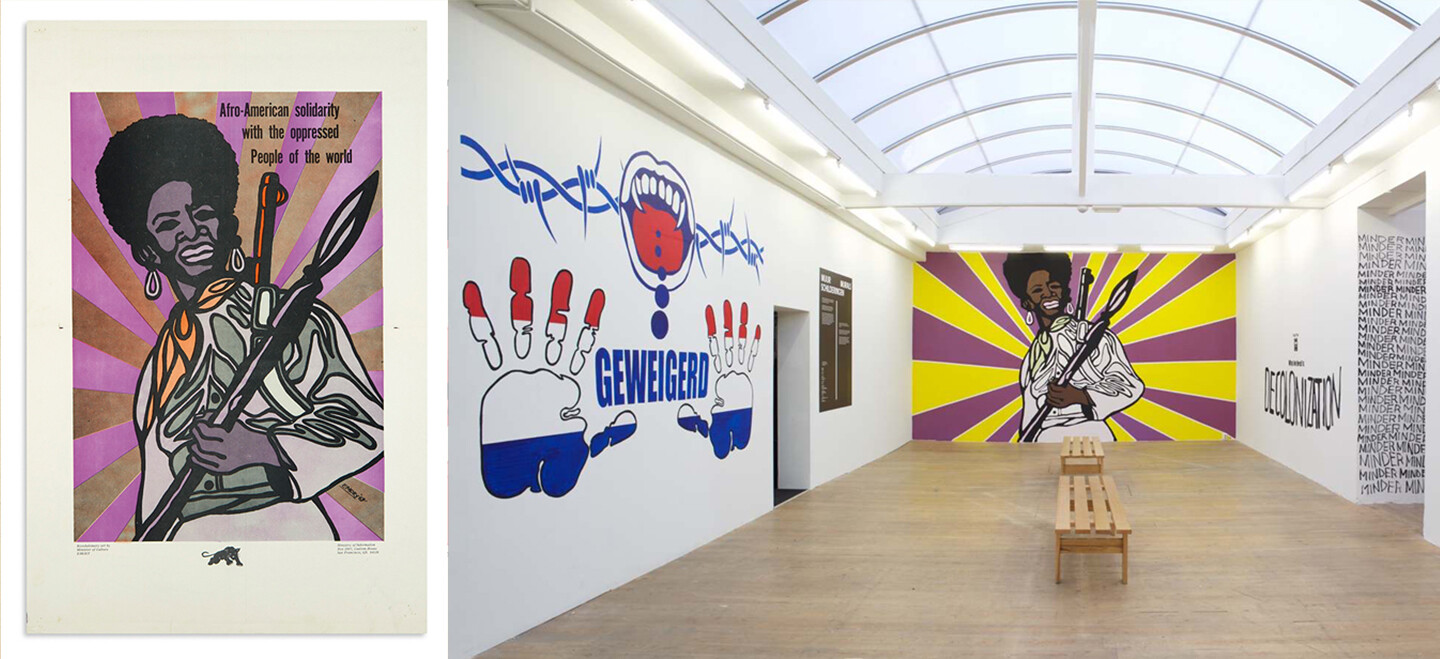

Left: Emory Douglas, Black Panther Party poster, 1969. Collection of Oakland Museum of
California. Right: Installation view of BELL Invites, curated by Vivian Ziherl and Aruna Vermeulen
at Stedelijk Museum Bureau Amsterdam, 2016, showing murals by Emory Douglas and the
University of Colour.
If Jackson’s fugitivity was transmuted into Deleuzian desertion, more problematic than such appropriation is the decades-long theoretical neglect of the main Black Panther theorist, Huey P. Newton, who is only now beginning to come into view as an “unacknowledged intellectual” of the New Left—albeit one with troubling moments and patterns in his biography.47 In Commonwealth, Hardt and Negri appear to begin a much-needed reassessment by noting the importance of Newton’s abandonment of his earlier Black nationalist “affirmation of identity”: Newton “progressively shifts the revolutionary framework from nationalism to internationalism and finally ‘intercommunalism’ in an effort to designate a theoretical framework for liberation that implies the abolition of racial identity and its structures of insubordination.”48 Newton’s intercommunalism was an attempt to articulate emergent forms of collective identification and collaboration beyond and against the nation-state. “We say that the world today is a dispersed collection of communities. A community is different from a nation. A community is a small unit with a comprehensive collection of institutions that serve to exist (sic) a small group of people.”49
Newton argued that the present world was stuck in a state of reactionary intercommunalism, which is marked by a struggle “between the small circle that administers and profits from the empire of the United States, and the peoples of the world who want to determine their own destinies.”50 Here, in other words, a “community” that is an imperial elite extracts value from the world in the framework of a nation-state become global hegemon. The diagnosis was prescient, even if some of the details are dated. For Newton, it was clear that “reactionary intercommunalism (empire)” needed to be replaced by “revolutionary intercommunalism.” He continues: “The people of the world, that is, must seize power from the small ruling circle and expropriate the expropriators.”51 The translation of this revolutionary horizon into revolutionary practice could take diverse and contradictory forms. On the one hand, Newton regarded China, North Korea, and Vietnam as “liberated territories” ruled by their people, or communities—though here he collapses his concept of communities back into that of a nation-state, ruled by a party that serves as the people’s avant-garde. The Black Panther Party, of course, modeled itself on such parties, and Newton’s Oakland chapter was clearly where the politburo was located.52 This is not the place for a disquisition on the tensions within and between Black Panther theory and practice. Nothing is to be sugarcoated, but Newton’s pronouncement that “there will always be contradictions or else everything would stop” suggests that even the most painful contradictions are to be worked with, and worked through.53
One particularly cogent feature of Newton’s thinking is his rejection of identitarian closure, and his insistence on intercommunal, or transversal, concatenation. His analysis of empire, as well as personal encounters, led him to the conviction that Black and gay liberation movements needed to combine their struggle, as both groups found themselves victimized and brutalized by the state apparatus.54 The Black Panthers should not be seen as an “identitarian” movement in any reductive sense, with Newton asserting the need for a “universal identity” created through the dialectical interplay of social groups and forces, opposing “cultural, racial, and religious chauvinism, the kind of ethnocentrism we have now.”55 While he appropriated Leninist/Maoist rhetoric and methods for the Black Panthers, his concept of community broadened the horizon of struggle and prevented him from getting bogged down in debates about class vs. race or class vs. gender. What united all the struggles and made intercommunalism a necessity was the various communities’ experience of oppression.
However, it is obviously not a given that such experience will actually be seen as a shared experience, and become the basis for solidarity and action. As John Narayan argues in an article that stages a critical dialogue between Newton, Deleuze, and Hardt/Negri, “Newton’s account of the divisive effects of reactionary intercommunalism on the multitude and the need to combat such effects” is a particularly productive feature of this thought,” providing “the missing link Hardt and Negri fail to provide in their account of the revolutionary assemblages of the multitude.”56 Newton’s insistence that “the material and ideological effects of empire provide real and significant obstacles to the unification of a globally dispersed revolutionary subject” has never been more relevant.57 From segments of the white working class supporting fascist candidates to Black anti-Semitism and feminist trans-bashing: the symptoms of reactionary intercommunalism abound.
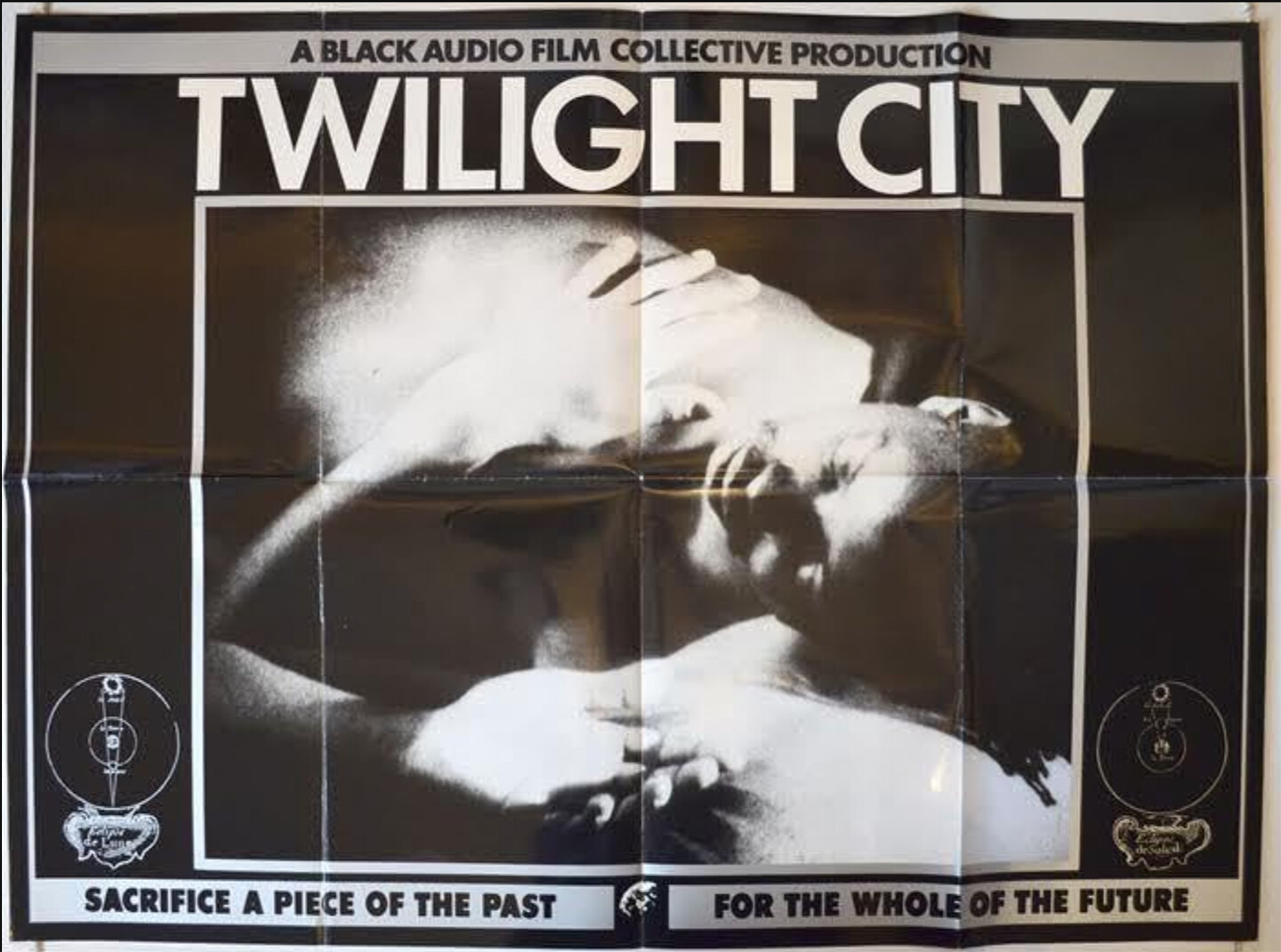

Black Audio Film Collective, Twilight City, poster, 1989.
The collision of identities is encapsulated beautifully by Twilight City (1989), an essay film by the Black Audio Film Collective, whose members were well-versed in American as well as British Black radical theory. Twilight City is set in an Afro-Caribbean community in Thatcherite London, which is being displaced as the Isle of Dogs is transformed into the Docklands financial district, a site of deterritorialized capital. The film’s fictional narrator and a number of “talking-head” interviewees reflect on a kind of negative intercommunalism talking hold: Paul Gilroy, for one, insists that in Thatcher’s London, people often inhabit the same physical space, being “physically proximate,” without actually encountering each other in any meaningful way.58 Communities are connected only negatively, as competitors; at worst, they become enemies subjecting each other to racist or homophobic violence.
The film’s narrator, in fact, reveals that such negative intercommunalism runs right through her, as her Caribbean mother has no way of understanding her participation in queer nightlife: “As the old London dissolves, the lost souls are becoming more visible.” Her friends are “creatures of the night” that her mother cannot accept. Her split identity is evoked in nocturnal views of London as well as through staged tableaux of aestheticized (male) bodies. This nightlife may well be seen as a desertion from Thatcherite London, with uncertain lines of divergence veering off into different trajectories, from careers in the arts and academia to truly marginalized forms of existence. Meanwhile, Gail Lewis notes that Black people now seem to move through London with more confidence, and that she is optimistic about the symbolic and cultural dimension but depressed when it comes to the material side of surviving in London.
Twilight City toured the festival circuit in the fall of 1989, around the time the Berlin Wall came down. In the wake of this historical event, Stuart Hall and Fredric Jameson had a conversation for the British magazine Marxism Today in which they grappled with the prospect that both the second and the third worlds would be “netted” in “a new world system” of post-1989 global capitalism—with the term “world system” again evoking the Marxist “world-systems theory” developed by Wallerstein.59 If both Jameson (the American Marxist theorist of postmodernism) and Hall (the Jamaican-British pioneer of cultural studies) where attentive readers of Raymond Williams, Jameson stresses the systemic and the dominant, whereas Hall sides with difference and emergence. For Jameson, postmodernism was marked by dominant culture becoming more pervasive and hegemonic than ever before. As a “tendentially complete modernization” in which “older remnants have been removed,” postmodernism is the apogee of cultural imperialism.60 Hall insists on a dialectical counterpoint: from his British postcolonial standpoint, what is key is that postmodern standardization and mass culture produce, in a dialectical reversal, “a proliferation of difference, of otherness.”61
In 1989, Hall had contributed two lectures to a symposium on “Culture, Globalization and the World-System” at Binghamton University, home to Immanuel Wallerstein and his institute.62 Here, Hall analyzed “the global postmodern” as falling short of becoming a “unitary regime,” in contrast to what certain French theorists decreed. Noting that “marginality has become a powerful space,” Hall asserts that “our lives have been transformed by the struggle of the margins to come into representation.”63 Hall was of course highly aware of the limits of identitarian representation under capitalist conditions, with Blackness having the potential to sabotage as well as foster solidarity.64 In the interview with Jameson, Hall seems more inclined to dwell on the problems: “Our sense of agency on the Left has always depended on a sense of coming together: solidarity—not just the ‘lonely rebel’ individual. But it’s exactly that sense of totality, of collective action and solidarity, which has been undermined by the new logic of ‘difference’ which dominates the era of the postmodern.”65
At Binghamton, Hall seemed more inclined to focus on potentiality. Invoking Williams, Hall went on to suggest that the marginal is a site of cultural emergence: “In the contemporary arts, I would go so far as to say that, increasingly, anybody who cares for what is creatively emergent in the modern arts will find that it has something to do with the languages of the margin.”66 However, we might also consider this notion of the marginal as troubling Williams’s conceptual distinctions: in the sphere of marginality, the residual and the emergent can be hard to disentangle. Twilight City, from the same year, certainly suggests that marginality is contested terrain. With the social margins intensifying the pressures and contradictions of the system, they can easily become divided and conflictual—breeding grounds for reactionary intercommunalism.
Continued in “Capitalism and Schismogenesis, Part 2”
Sandro Mezzadra, “Deserting the War,” trans. Kelly Mulvaney, transversal texts, March 2022 →.
Kenneth Pomeranz, The Great Divergence: China, Europe, and the Making of the Modern World Economy (Princeton University Press, 2000).
See Paul Raekstad, “Revolutionary Practice and Prefigurative Politics: A Clarification and Defense,” Constellations, no. 25 (2018) →.
Otto Neurath, Lebensgestaltung und Klassenkampf (Laubsche Verlagsbuchhandlung, 1928), 19. The declension in the text is “kommender Lebensstimmung.”
Neurath, Lebensgestaltung und Klassenkampf, 23.
On the genealogy of Lebensform/life-form/form-of-life, see my essay “Habitual Art History,” in In the Maze of Media: Essays on the Pathways of Art after Minimalism, ed. André Rottmann (Transcript, forthcoming 2023).
Raymond Williams, “Base and Superstructure in Marxist Cultural Theory” (1973), in Culture and Materialism (Verso, 2005), 43.
Raymond Williams, Marxism and Literature (Oxford University Press, 1977), 123.
Perry Anderson, Arguments within English Marxism (Verso, 1980), 20.
Williams, Marxism and Literature, 126.
Williams, “Base and Superstructure,” 40.
For this usage, see for instance Selma James, “Sex, Race, and Class” (1974), in Sex, Race, And Class—The Perspective of Winning: A Selection of Writings, 1951–2011 (PM Press, 2012), 97, 100; and Sheila Rowbotham, “The Women’s Movement & Organizing for Socialism” (1979), in Sheila Rowbotham, Lynne Segal, and Hilary Wainwright, Beyond the Fragments: Feminism and the Making of Socialism (Merlin Press, 1979/2013), 181.
James, “Sex, Race, and Class,” 96.
James, “Sex, Race, and Class,” 98, 99, emphasis in original.
For a critique of the notion of the ally, see for instance Laurel Mei-Singh and Davianna Pōmaika‘i McGregor, “To Be Done with Allyship: Towards Oceanic Justice in the Pacific,” The Funambulist, no. 46 (March–April 2023).
More recently, Maurizio Lazzarato has pursued this reading of Tarde. See for instance Lazzarato, “From Capital-Labour to Capital-Life,” trans. Valerie Fournier, Akseli Virtanen and Jussi Vähämäki, Ephemera 4, no. 3 (2004).
Gilles Deleuze and Félix Guattari, A Thousand Plateaus: Capitalism and Schizophrenia, vol. 2 (1980), trans. Brian Massumi (Bloomsbury, 2013), 255.
Deleuze and Guattari, A Thousand Plateaus, 253.
Gabriel Tarde, “Preface to the Second Edition,” The Laws of Imitation, trans. Elsie Clews Parsons (Henry Holt, 1903), xiv.
Deleuze and Guattari, A Thousand Plateaus, 219, emphasis in original.
Tarde, “Preface to the Second Edition,” Laws of Imitation, xviii.
Gabriel Tarde, “Le Public et la foule” (1898), in L’Opinion et la foule (Félix Alcan, 1901), 48–49, 56–57. Today, as the dialectic of crowds and print publics has given way to one of crowds and networks, parliaments are stormed by mobs organized on Facebook and Telegram. Just like Tarde’s print publics, today’s networks have great criminal potential. Does this becoming-criminal begin when the network materializes as a physical mob, or before?
Denis Staunton, “‘Anger and Hate Easiest Way to Grow on Facebook,’ Says Whistleblower,” Irish Times, October 25, 2021 →.
For the notion of calculated publics, see Tarleton Gillespie, “The Relevance of Algorithms,” in Media Technologies: Essays on Communication, Materiality, and Society, ed. Tarleton Gillespie, Pablo. J. Boczkowski, and Kirsten A. Foot (MIT Press, 2014).
Deleuze and Guattari, A Thousand Plateaus, 20–21.
Deleuze and Guattari, A Thousand Plateaus, 22.
Gregory Bateson, “Bali: The Value System of a Steady State” (1949), in Steps to an Ecology of Mind (University of Chicago Press, 1972).
See Matei Candea, “Revisiting Tarde’s House,” in The Social After Gabriel Tarde: Debates and Assessments (Routledge, 2010), 20n10.
Gregory Bateson, Naven: A Survey of the Problems Suggested by a Composite Picture of the Culture of a New Guinea Tribe Drawn from Three Points of View (Cambridge University Press, 1936), 171–197.
Bateson, “Bali,” 113, 115.
Bateson, Naven, 184.
Bateson, Naven, 186.
See the 1958 epilogue in Bateson, Naven.
Rodrigo Nunes, Neither Vertical nor Horizontal (Verso, 2021), 63.
Bateson first developed the concept in the article “Culture Contact and Schismogenesis” in Man, no. 35 (1935), and at book length in Naven.
“Clastres judiciously opposes the verticalizing and centripetal dynamics—differentiation by complementary schismogenesis, as Bateson would say—of the Chibcha, Aruaque and Carib peoples of this zone, to the horizontalizing and centrifugal dynamics—i.e. by symmetrical schismogenesis—which motivates the Tupi-Guarani people, hostile to social stratification.” Eduardo Viveiros de Castro, Politique des multiplicités: Pierre Clastres face à l’état (Ed. Dehors, 2019), 88. My translation.
Pierre Clastres, La Société contre l’Etat (Minuit, 1974).
David Graeber and David Wengrow, The Dawn of Everything: A New History of Humanity (Allen Lane, 2021), 57, emphasis in original. The motif of schismogenesis also shows up in some previous work by Graeber, such as the “Theses on Kingship” coauthored with Marshall Sahlins, which introduces the line of inquiry pursued in The Dawn of Everything. See Graeber and Marshall Sahlins, On Kings (Hau Books, n.d. (2017)), 1–22.
Graeber and Wengrow, Dawn of Everything, 27–77.
Graeber and Wengrow, Dawn of Everything, 449–50.
Graeber and Wengrow, Dawn of Everything, 231.
For cautioning remarks about the dangers of disregarding “collective struggle by actual minorities” in favor of “creative minorities yet to come,” see Donna V. Jones, The Racial Discourses of Life Philosophy: Négritude, Vitalism, and Modernity (Columbia University Press, 2010), 71.
Isabelle Stengers, “Comparison as a Matter of Concern,” in Common Knowledge 17, no. 1 (Winter 2011): 59.
See also Isabelle Stengers, In Catastrophic Times: Resisting the Coming Barbarism, trans. Andrew Goffey (Open Humanities Press/Meson Press, 2015), 23–24.
Deleuze and Guattari, A Thousand Plateaus, 239.
Stefano Harney and Fred Moten, The Undercommons: Fugitive Planning and Black Study (Minor Compositions, 2013), 64.
John Narayan, “Huey P. Newton’s Intercommunalism: An Unacknowledged Theory of Empire,” Theory, Culture & Society 36, no. 3 (2019): 1–2. Patterns of misogynist violence in the Black Panther Party must be addressed as part of an overall reassessment of the movement’s strengths and shortcomings.
Michael Hardt and Antonio Negri, Commonwealth (Harvard University Press, 2009), 336.
Huey P. Newton, “Intercommunalism” (1974), Viewpoint Magazine, June 11, 2018 →.
Newton, “Intercommunalism.” An early lecture by Newton on intercommunalism was published in The Black Panther 5, no. 30 (January 23, 1971). The newpaper would soon change its subtitle from Black Community News Service to Intercommunal News Service.
Newton, “Intercommunalism.”
Delio Vásquez avers that “the Oakland chapter ended up in practice functioning as yet another political body, in addition to the FBI and local police, that some local chapters found themselves pitted against.” Vásquez, “Intercommunalism: The Late Theorizations of Huey P. Newton, ‘Chief Theoretician’ of the Black Panther Party,” Viewpoint Magazine, June 11, 2018 →.
Newton, “Intercommunalism.”
See Jared Leighton, “‘All of Us Are Unapprehended Felons’: Gay Liberation, the Black Panther Party, and Intercommunal Efforts Against Police Brutality in the Bay Area,” Journal of Social History 52, no. 3 (2019).
Newton, “Intercommunalism.”
Narayan, “Huey P. Newton’s Intercommunalism,” 15, 18.
Quoted in Narayan, “Huey P. Newton’s Intercommunalism,” 16.
Hardt and Negri read Newton’s anti-identitarianism as “the basis of Paul Gilroy’s efforts to shift the discourse of black politics toward an abolition of race.” Hardt and Negri, Commonwealth, 336.
Here I am combining elements from statements by both Jameson and Hall in “Interview with Stuart Hall” (1990), in Jameson on Jameson: Conversations on Cultural Marxism, ed. Ian Buchanan (Duke University Press, 2007), 120. This conversation originally appeared in the September 1990 issue of Marxism Today under the telling title “Clinging to the Fragments.”
Jameson in “Interview with Stuart Hall,” 114. For Jameson’s Williams-derived notion of postmodernism as “cultural dominant,” see Postmodernism, or, The Cultural Logic of Late Capitalism (Duke University Press, 1991), 6.
Hall in “Interview with Stuart Hall,” 116.
See the second and definitive edition of the conference volume edited by Anthony D. King, Culture, Globalization and the World-System: Contemporary Conditions for the Representation of Identity (University of Minnesota Press, 1997).
Stuart Hall, “The Local and the Global: Globalization and Ethnicity,” in Culture, Globalization and the World-System, 32, 34.
Hall in “Interview with Stuart Hall,” 118.
Hall in “Interview with Stuart Hall,” 118.
Hall, “The Local and the Global,” 34.
Category
Subject
This essay is based on a chapter of my forthcoming book States of Divergence. For various reasons, including feedback on early drafts or for productive comments at conferences and symposia, I would like to thank James Clifford, Stewart Martin, and Stevphen Shukaitis.
